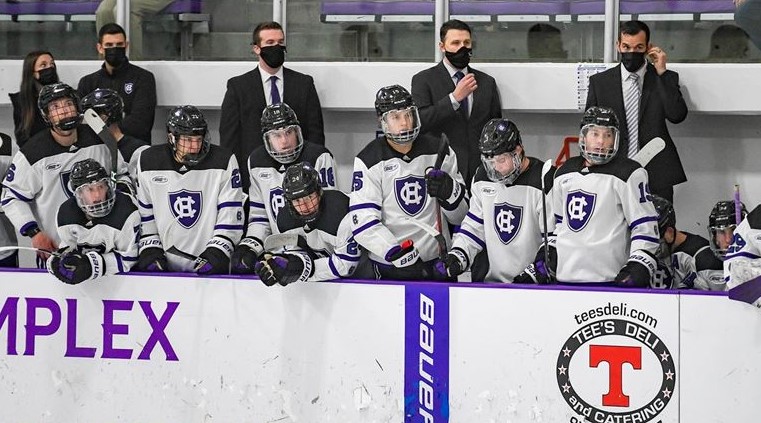
Each week during the season, we look at the big events and big games around Division I men’s college hockey in Tuesday Morning Quarterback.
Ed: Another week, another new No. 1 in the USCHO.com men’s ice hockey poll, with St. Cloud State gaining the top spot after Michigan split with Western Michigan. The Wolverines are the third straight team to lose a game in the weekend following the poll voters declaring them the top team in the country.
Let’s start with that intrastate non-conference series. Friday’s win on the road at Yost by Western Michigan was a big one for first-year head coach Pat Ferschweiler’s team. They bounded out to a 3-0 lead by the middle of the game and had five different players score in a 5-2 win.
On Saturday, with the other half of the home-and-home series played at WMU’s Lawson Ice Arena, it took overtime for the Wolverines to avenge the previous night’s loss, 3-2.
While teams like North Dakota, St. Cloud, Minnesota Duluth, and Denver all seem to get the notice and get the hype in their conference, are the Broncos (pun absolutely intended) the dark horse in the NCHC?
Paula: I’m not sure you can call the Broncos a dark horse, given the strides they made in two seasons (2018-19, 2019-20) before the dive they took in the first part of last season. In their last 10 regular-season games in 2020-21, the Broncos were 7-3-0, with three wins over St. Cloud State and a two-game sweep of Minnesota Duluth.
There are 15 sophomores on the Western roster. Last year was a rebuilding year, for sure, and rebuilding during truly unusual circumstances. I think the Broncos should be considered part of the always excellent NCHC mix. That they were picked sixth in the NCHC preseason media poll this year after finishing last in 2020-21 says less about Western Michigan, I think, than it does about the strength of the five teams picked ahead of them: St. Cloud, Minnesota Duluth, North Dakota, Denver and Omaha.
I put the Broncos ninth in my poll this week, and I think that’s a fair representation of where they are. For what it’s worth, I dropped the Wolverines to fourth. Western climbed to No. 13 this week and Michigan fell to No. 4. These are snapshots, as we know.
And, yes, this was a big weekend for the Broncos and Ferschweiler.
Speaking of the poll, I do find it interesting that St. Cloud is the new No. 1 and that the votes were so split. Last week, Michigan received 45 votes for the top spot. This week, St. Cloud swept Wisconsin and earned 22 first-place votes and Michigan still 17 votes for first place. Meanwhile, Minnesota Duluth swept a really tough Minnesota team – demonstrably tougher than Wisconsin – and improved to 5-1-0 yet earned only three votes for first place. Also, last week’s second-place team, Minnesota State, didn’t play but slid to third with eight votes for the top spot.
Ed, what do you make of the movement among the top teams in the poll? It’s hard for me to fall back on the old strength-of-schedule argument, given Minnesota’s and Wisconsin’s relative differences. Is it too soon to make anything of this, or are voters just trying get a grip on things in the early going?
Ed: Well, Paula, I think there are a few things going on. And some of this will reveal my thinking when I’m assembling my ballot.
First, Michigan’s continued strength in the poll after a loss is a recognition that Western Michigan is very good and that no team is going to be unbeaten this season. Even the best teams will have a bump in the road. Meanwhile, the first-place votes for St. Cloud reflect their record thus far as well as the trouncing the Huskies gave Wisconsin over the weekend.
Voters also look at what the teams in the previous week’s poll have done. When six of the top 10 teams have losses on the weekend, the next step in ranking them is to see whether there are teams to move up, or whether you vote the status quo. When I see a loss by a ranked team to an unranked or much lower-ranked team, I try to dig into the details of the loss. Did the losing team dominate in shots? Were power plays lopsided? Did a goalie stand on his head? These are all factors that go into subjectively evaluating teams. (I’ll use this opportunity to note that the Pairwise Rankings are essentially meaningless this early in the season and have more validity as we reach January.)
And yes, there is a sense of getting a grip.
While we’re talking poll movement, Quinnipiac climbed two spots in the poll to No. 5 while North Dakota stood pat in sixth after the two teams split a series in Connecticut. The Bobcats are the first team from an eastern conference to crack the top five since UMass got bounced from the preseason No. 1 after its season-opening sweep at the hands of Minnesota State.
Speaking of numbers behind the numbers, it was impressive to me that Quinnipiac limited North Dakota to 16 shots on Friday and 19 on Saturday, while racking up 28 and 35 respectively. That combination of a solid offensive attack and a throttling defense can take you a long way.
Even though it’s still early, what can we take away from this series? Are the Bobcats shaping up to be the best in the east this season?
Paula: It’s funny that you ask about the Bobcats, because they’re a team I always have a difficult time warming up to. I had them 16th in my poll last week and eighth this week – not an unusual jump for me at the start of a season, when I’m figuring out who may have the goods while also trying to provide a reflection of what’s going on in the here and now.
Quinnipiac, though, is a puzzle for me. The Bobcats had an outstanding season last year in a conference where the four league teams had to scramble to create full schedules for competition. They welcome five transfers – including goaltender Dylan St. Cyr from Notre Dame and forward Oliver Chau, both solid players additions – who provide even more depth and maturity to a team that has a lot of experience.
Since 2018, the Bobcats have been steady and competitive but seem to have lacked that thing, that whatever-it-is, to convince me that they’re an upper-echelon team, but this year’s squad looks as though it has the ingredients to challenge for a national title.
One thing that Quinnipiac has that only three other teams in the ECAC also possess is the experience of last year. I think that year away from hockey for everyone other than the Quinnipiac, Clarkson, Colgate and St. Lawrence is going to impact the ECAC in ways that we haven’t yet seen. Those four teams that played have worked out most – and worked with – most issues that arise from life in COVID times, and even though the other coaches will benefit from the advice of those who have lived it, there’s nothing like experience.
It will take a while for things to come together overall in that league, I think.
Add the talent and maturity of the Bobcats to that experience, and I definitely see that they have an advantage this season. It’s early, but the ECAC may be theirs to lose.
As it is early and we are extrapolating on very little data, what do you make of RIT’s split with Notre Dame? An OT win for the Tigers followed by a decisive thumping by the Fighting Irish – and you were there. Can you shed any light on either team?
Full confession: Notre Dame, like Quinnipiac, is another team from whom I need proof before I buy in.
Ed: Both teams will contend for their league championship and Notre Dame for sure on the national scene.
On Thursday, RIT probably had the best forward line and got superb goaltending from junior Kolby Matthews, who is 3-0-1 with a 1.96 GAA and .942 save percentage. Matthews made a huge save 17 seconds into overtime which led to the game-winner 13 seconds later.
On Friday, Notre Dame jumped to an early lead against a freshman goalie in his first game and didn’t look back, while the Irish got spotless goaltending from former Cornell standout Matthew Galajda. Performances like Matthews’ and Galajda’s will take each team a long way.
Let’s wrap with a trio of firsts.
Holy Cross coach Bill Riga and Colorado College’s Kris Mayotte are both longtime former assistants with successful programs and each got their first win last weekend, while at St. Thomas, Rico Blasi saw his Tommies notch their first D-I victory.
Both Riga and Mayotte are bound to move their programs forward, and after a couple of years away from coaching, Blasi gets to build a new one.
You covered Blasi at Miami in his journey from a 27-year-old rookie to a veteran with a team that contended every season. What does Rico at 49 bring to this new program with the experience of those great years at his alma mater under his belt and maybe some adversity at the end?
Paula: Well, Blasi brings a lot to St. Thomas. His Miami team won the CCHA tournament title in 2011 and the NCHC title in 2015. Under Blasi, Miami made 10 NCAA tournament appearances and back-to-back Frozen Four appearances in 2009 – when the RedHawks lost to Boston University in the title game – and 2010.
All of that is an asset, but the Frozen Four appearances are especially valuable for a coach who’s building a new program. Blasi knows exactly how hard it is to get a team to that point.
He’s also brought in two assistants with complementary skillsets in Northeastern alum Leon Hayward and Minnesota alum, Cory Laylin. Hayward coached most recently with Colorado College and his pro career spanned six years in the ECHL and AHL. From 1992 through 2008, Laylin played for a variety of teams in North American and Europe, and he most recently coached the D-II Hamline University team in St. Paul, Minn. Hayward and Laylin have overlapping hockey communities from which to recruit, and Laylin’s Minnesota ties are helpful.
And something that shouldn’t be overlooked is that Blasi returns to coaching in a conference that feels familiar. Four of the teams in the new CCHA played Miami in the old CCHA, and everyone in that conference is someone that Blasi had at least a good acquaintance with prior to taking the job at St. Thomas. It’s a league that should feel familiar to Blasi, and he has a lot of support from the coaches in the CCHA who want to see the new program at St. Thomas succeed.


